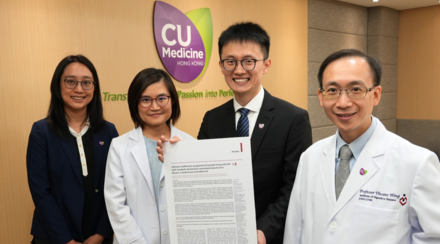CUHK Survey: About 90% Hepatitis C Patients Unaware of Infection and Majority Refuses Treatment
The Center for Liver Health of The Chinese University of Hong Kong (CUHK) and the Caritas Lok Heep Club jointly launched a ‘New Life, New Liver’ programme in 2009 to provide Hepatitis C virus (HCV) screening services and education for high-risk individuals who might have contracted HCV through sharing syringes. Findings of the programme indicated that 56% of this high-risk group were diagnosed with HCV and over 90% of them were unaware of infection. Among the patients, only 20% were willing to receive medical treatment which is quite harsh.
HCV is mainly transmitted through blood or body fluid and is the main cause of liver cirrhosis and liver cancer, affecting approximately 150 million people worldwide. Hepatitis C is difficult to be detected during its early stage when the symptoms are not obvious. Usually it will have progressed to liver failure or liver cancer when evident symptoms arise such as jaundice, dark urine or abdominal pain.
The ‘New Life, New Liver’ programme conducted between 2009 and 2012 screened a total of 234 individuals who were at high risk of contracting HCV. 130 subjects (56%) were found to carry the virus and 15 subjects (6.4%) had already developed cirrhosis. Regrettably, among the HCV-carriers, only 69 (53%) were willing to be regularly observed by health care professionals, and just 26 patients (20%) decided to receive medical treatment.
Conventional medical treatment for HCV requires weekly injection of peginterferon which may incur numerous side effects including fever and depression. The process is arduous and the success rate of eradicating the virus is just about 50%. A participant of the programme described the treatment as grueling and disappointing as it failed to clear the HCV in his body. In recent years, there have been new breakthroughs in HCV treatment using direct-acting antivirals (DAAs). The latest antiviral drug can be administered alone and the success rate of eradicating HCV exceeds 90%. The peginterferon-free DAAs carry fewer side effects and can effectively reduce the risks of cirrhosis and liver cancer.
Professor Henry L.Y. Chan, Director of the Center for Liver Health at CUHK, remarked, ‘The development of DAAs has opened a new chapter for HCV treatment. New DAAs does not only cause much fewer side effects, but it also lowers the risk of cirrhosis and liver cancer. However, the cost of treatment involving DAAs is notably higher and the associated drugs have yet to be registered under the Hospital Authority Drug Formulary, which means they are not readily available to the general public. Although conventional HCV treatment cannot guarantee eradication of HCV, we still encourage patients to receive treatment to control the disease.’ The Center for Liver Health also calls upon the public to avoid sharing syringes and unprotected sex to prevent contraction of HCV.
The Center for Liver Health at CUHK is dedicated to the education and prevention of HCV.In addition to offering screening and related services to patients in need, the Center also organizes health talks to raise awareness among the public and the medical professionals on HCV, its social impacts and treatment methods. Interested parties are welcome to contact the Center at 3505 1298.
.jpg)
Prof. Henry L.Y. CHAN (right), Director, and Professor Vincent W. S. WONG, Deputy Director, Center for Liver Health, CUHK.





















